Lalan Kumar
Brain Age Group Classification Based on Resting State Functional Connectivity Metrics
Mar 27, 2025



Abstract:This study investigated age-related changes in functional connectivity using resting-state fMRI and explored the efficacy of traditional deep learning for classifying brain developmental stages (BDS). Functional connectivity was assessed using Seed-Based Phase Synchronization (SBPS) and Pearson correlation across 160 ROIs. Clustering was performed using t-SNE, and network topology was analyzed through graph-theoretic metrics. Adaptive learning was implemented to classify the age group by extracting bottleneck features through mobileNetV2. These deep features were embedded and classified using Random Forest and PCA. Results showed a shift in phase synchronization patterns from sensory-driven networks in youth to more distributed networks with aging. t-SNE revealed that SBPS provided the most distinct clustering of BDS. Global efficiency and participation coefficient followed an inverted U-shaped trajectory, while clustering coefficient and modularity exhibited a U-shaped pattern. MobileNet outperformed other models, achieving the highest classification accuracy for BDS. Aging was associated with reduced global integration and increased local connectivity, indicating functional network reorganization. While this study focused solely on functional connectivity from resting-state fMRI and a limited set of connectivity features, deep learning demonstrated superior classification performance, highlighting its potential for characterizing age-related brain changes.
EEG-based 90-Degree Turn Intention Detection for Brain-Computer Interface
Oct 15, 2024Abstract:Electroencephalography (EEG)--based turn intention prediction for lower limb movement is important to build an efficient brain-computer interface (BCI) system. This study investigates the feasibility of intention detection of left-turn, right-turn, and straight walk by utilizing EEG signals obtained before the event occurrence. Synchronous data was collected using 31-channel EEG and IMU-based motion capture systems for nine healthy participants while performing left-turn, right-turn, and straight walk movements. EEG data was preprocessed with steps including Artifact Subspace Reconstruction (ASR), re-referencing, and Independent Component Analysis (ICA) to remove data noise. Feature extraction from the preprocessed EEG data involved computing various statistical measures (mean, median, standard deviation, skew, and kurtosis), and Hjorth parameters (activity, mobility, and complexity). Further, the feature selection was performed using the Random forest algorithm for the dimensionality reduction. The feature set obtained was utilized for 3-class classification using XG boost, gradient boosting, and support vector machine (SVM) with RBF kernel classifiers in a five-fold cross-validation scheme. Using the proposed intention detection methodology, the SVM classifier using an EEG window of 1.5 s and 0 s time-lag has the best decoding performance with mean accuracy, precision, and recall of 81.23%, 85.35%, and 83.92%, respectively, across the nine participants. The decoding analysis shows the feasibility of turn intention prediction for lower limb movement using the EEG signal before the event onset.
Exploring Brain Network Organization in Alzheimer Disease and Frontotemporal Dementia: A Crossplot Transition Entropy Approach
Sep 25, 2024Abstract:Dementia poses a growing challenge in our aging society. Frontotemporal dementia (FTD) and Alzheimer disease (AD) are the leading causes of early-onset dementia. FTD and AD display unique traits in their onset, progression, and treatment responses. In particular, FTD often faces a prolonged diagnostic process and is commonly misdiagnosed with AD due to overlapping symptoms. This study utilizes a complex network model of brain electrical activity using resting-state EEG recordings to address the misdiagnosis. It compares the network organization between AD and FTD, highlighting connectivity differences and examining the significance of EEG signals across frequency bands in distinguishing AD and FTD. The publicly available EEG dataset of 36 AD and 23 FTD patients is utilized for analyses. Cross-plot transition entropy (CPTE) is employed to measure synchronization between EEG signals and construct connection matrices. CPTE offers advantages in parameter setting, computational efficiency, and robustness. The analysis reveals significantly different clustering coefficients (CC), subgraph centrality (SC), and eigenvector centrality (EC) between the two groups. FTD shows higher connectivity, particularly in delta, theta, and gamma bands, owing to lower neurodegeneration. The CPTE-based network parameters effectively classify the two groups with an accuracy of 87.58\%, with the gamma band demonstrating the highest accuracy of 92.87%. Consequently, CPTE-based, complex network analysis of EEG data from AD and FTD patients reveals significant differences in brain network organization. The approach shows potential for identifying unique characteristics and providing insights into the underlying pathophysiological processes of the various forms of dementia, thereby assisting in accurate diagnosis and treatment.
sEMG-Driven Physics-Informed Gated Recurrent Networks for Modeling Upper Limb Multi-Joint Movement Dynamics
Aug 29, 2024Abstract:Exoskeletons and rehabilitation systems offer great potential for enhancing human strength and recovery through advanced human-machine interfaces (HMIs) that adapt to movement dynamics. However, the real-time application of physics-informed neural networks (PINNs) is limited by their reliance on fixed input lengths and surrogate models. This study introduces a novel physics-informed Gated Recurrent Network (PiGRN) designed to predict multi-joint torques using surface electromyography (sEMG) data. The PiGRN model employs a Gated Recurrent Unit (GRU) to convert time-series sEMG inputs into multi-joint kinematics and external loads, which are then integrated into an equation of motion to ensure consistency with physical laws. Experimental validation with sEMG data from five participants performing elbow flexion-extension tasks showed that the PiGRN model accurately predicted joint torques for 10 unfamiliar movements, with RMSE values between 4.02\% and 11.40\% and correlation coefficients ranging from 0.87 to 0.98. These findings highlight the PiGRN's potential for real-time exoskeleton and rehabilitation applications. Future research will explore more diverse datasets, improve musculoskeletal models, and investigate unsupervised learning methods.
ESI-GAL: EEG Source Imaging-based Kinematics Parameter Estimation for Grasp and Lift Task
Jun 18, 2024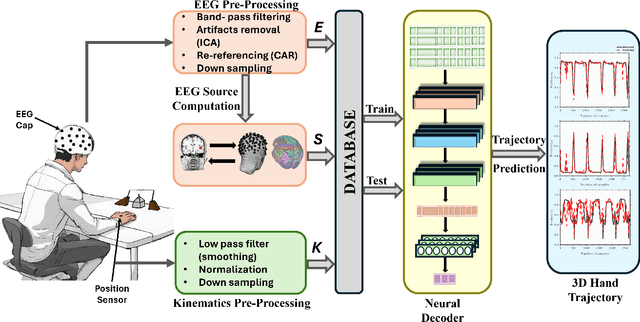
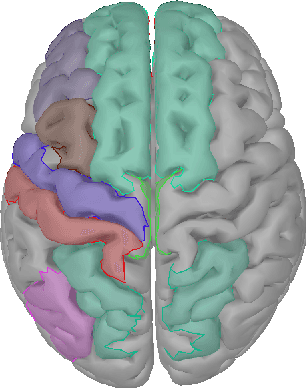


Abstract:Objective: Electroencephalogram (EEG) signals-based motor kinematics prediction (MKP) has been an active area of research to develop brain-computer interface (BCI) systems such as exosuits, prostheses, and rehabilitation devices. However, EEG source imaging (ESI) based kinematics prediction is sparsely explored in the literature. Approach: In this study, pre-movement EEG features are utilized to predict three-dimensional (3D) hand kinematics for the grasp-and-lift motor task. A public dataset, WAY-EEG-GAL, is utilized for MKP analysis. In particular, sensor-domain (EEG data) and source-domain (ESI data) based features from the frontoparietal region are explored for MKP. Deep learning-based models are explored to achieve efficient kinematics decoding. Various time-lagged and window sizes are analyzed for hand kinematics prediction. Subsequently, intra-subject and inter-subject MKP analysis is performed to investigate the subject-specific and subject-independent motor-learning capabilities of the neural decoders. The Pearson correlation coefficient (PCC) is used as the performance metric for kinematics trajectory decoding. Main results: The rEEGNet neural decoder achieved the best performance with sensor-domain and source-domain features with the time lag and window size of 100 ms and 450 ms, respectively. The highest mean PCC values of 0.790, 0.795, and 0.637 are achieved using sensor-domain features, while 0.769, 0.777, and 0.647 are achieved using source-domain features in x, y, and z-directions, respectively. Significance: This study explores the feasibility of trajectory prediction using EEG sensor-domain and source-domain EEG features for the grasp-and-lift task. Furthermore, inter-subject trajectory estimation is performed using the proposed deep learning decoder with EEG source domain features.
Insights into Age-Related Functional Brain Changes during Audiovisual Integration Tasks: A Comprehensive EEG Source-Based Analysis
Nov 27, 2023



Abstract:The seamless integration of visual and auditory information is a fundamental aspect of human cognition. Although age-related functional changes in Audio-Visual Integration (AVI) have been extensively explored in the past, thorough studies across various age groups remain insufficient. Previous studies have provided valuable insights into agerelated AVI using EEG-based sensor data. However, these studies have been limited in their ability to capture spatial information related to brain source activation and their connectivity. To address these gaps, our study conducted a comprehensive audiovisual integration task with a specific focus on assessing the aging effects in various age groups, particularly middle-aged individuals. We presented visual, auditory, and audio-visual stimuli and recorded EEG data from Young (18-25 years), Transition (26- 33 years), and Middle (34-42 years) age cohort healthy participants. We aimed to understand how aging affects brain activation and functional connectivity among hubs during audio-visual tasks. Our findings revealed delayed brain activation in middleaged individuals, especially for bimodal stimuli. The superior temporal cortex and superior frontal gyrus showed significant changes in neuronal activation with aging. Lower frequency bands (theta and alpha) showed substantial changes with increasing age during AVI. Our findings also revealed that the AVI-associated brain regions can be clustered into five different brain networks using the k-means algorithm. Additionally, we observed increased functional connectivity in middle age, particularly in the frontal, temporal, and occipital regions. These results highlight the compensatory neural mechanisms involved in aging during cognitive tasks.
Modeling and parametric optimization of 3D tendon-sheath actuator system for upper limb soft exosuit
Jun 30, 2023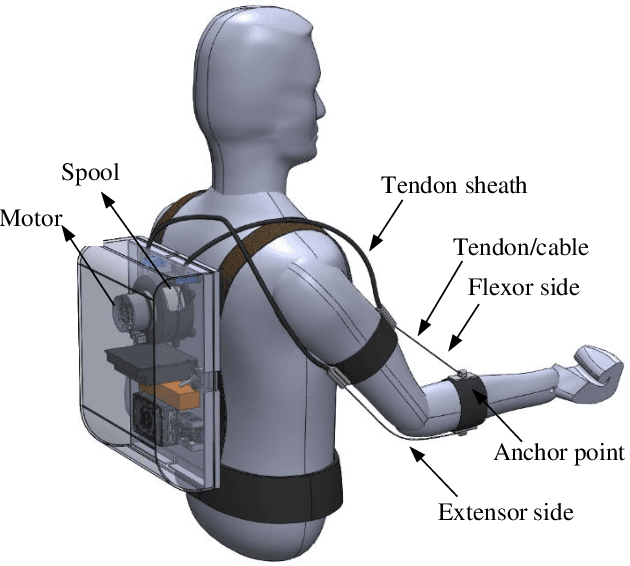
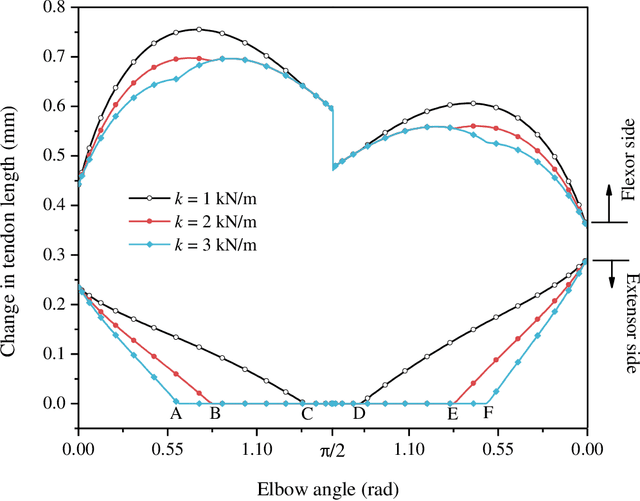
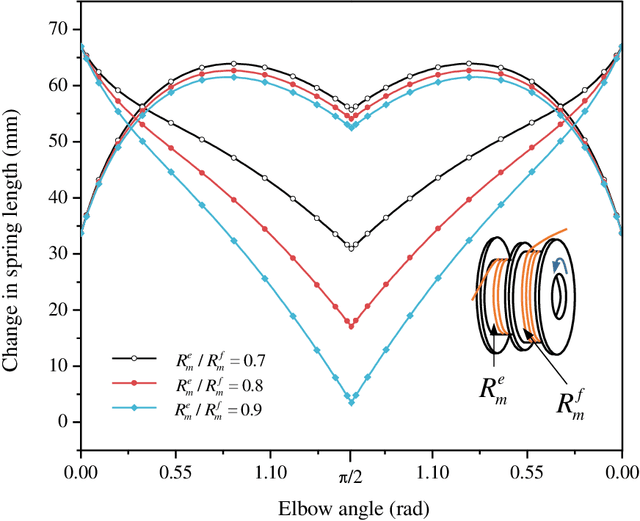
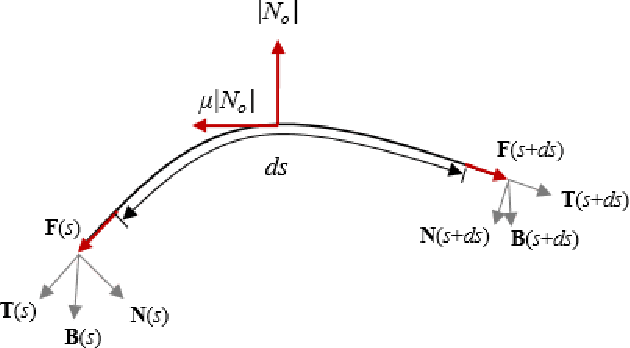
Abstract:This paper presents an analysis of parametric characterization of a motor driven tendon-sheath actuator system for use in upper limb augmentation for applications such as rehabilitation, therapy, and industrial automation. The double tendon sheath system, which uses two sets of cables (agonist and antagonist side) guided through a sheath, is considered to produce smooth and natural-looking movements of the arm. The exoskeleton is equipped with a single motor capable of controlling both the flexion and extension motions. One of the key challenges in the implementation of a double tendon sheath system is the possibility of slack in the tendon, which can impact the overall performance of the system. To address this issue, a robust mathematical model is developed and a comprehensive parametric study is carried out to determine the most effective strategies for overcoming the problem of slack and improving the transmission. The study suggests that incorporating a series spring into the system's tendon leads to a universally applicable design, eliminating the need for individual customization. The results also show that the slack in the tendon can be effectively controlled by changing the pretension, spring constant, and size and geometry of spool mounted on the axle of motor.
Brain Connectivity Features-based Age Group Classification using Temporal Asynchrony Audio-Visual Integration Task
May 01, 2023



Abstract:The process of integration of inputs from several sensory modalities in the human brain is referred to as multisensory integration. Age-related cognitive decline leads to a loss in the ability of the brain to conceive multisensory inputs. There has been considerable work done in the study of such cognitive changes for the old age groups. However, in the case of middle age groups, such analysis is limited. Motivated by this, in the current work, EEG-based functional connectivity during audiovisual temporal asynchrony integration task for middle-aged groups is explored. Investigation has been carried out during different tasks such as: unimodal audio, unimodal visual, and variations of audio-visual stimulus. A correlation-based functional connectivity analysis is done, and the changes among different age groups including: young (18-25 years), transition from young to middle age (25-33 years), and medium (33-41 years), are observed. Furthermore, features extracted from the connectivity graphs have been used to classify among the different age groups. Classification accuracies of $89.4\%$ and $88.4\%$ are obtained for the Audio and Audio-50-Visual stimuli cases with a Random Forest based classifier, thereby validating the efficacy of the proposed method.
EEG Cortical Source Feature based Hand Kinematics Decoding using Residual CNN-LSTM Neural Network
Apr 13, 2023Abstract:Motor kinematics decoding (MKD) using brain signal is essential to develop Brain-computer interface (BCI) system for rehabilitation or prosthesis devices. Surface electroencephalogram (EEG) signal has been widely utilized for MKD. However, kinematic decoding from cortical sources is sparsely explored. In this work, the feasibility of hand kinematics decoding using EEG cortical source signals has been explored for grasp and lift task. In particular, pre-movement EEG segment is utilized. A residual convolutional neural network (CNN) - long short-term memory (LSTM) based kinematics decoding model is proposed that utilizes motor neural information present in pre-movement brain activity. Various EEG windows at 50 ms prior to movement onset, are utilized for hand kinematics decoding. Correlation value (CV) between actual and predicted hand kinematics is utilized as performance metric for source and sensor domain. The performance of the proposed deep learning model is compared in sensor and source domain. The results demonstrate the viability of hand kinematics decoding using pre-movement EEG cortical source data.
BiCurNet: Pre-Movement EEG based Neural Decoder for Biceps Curl Trajectory Estimation
Jan 10, 2023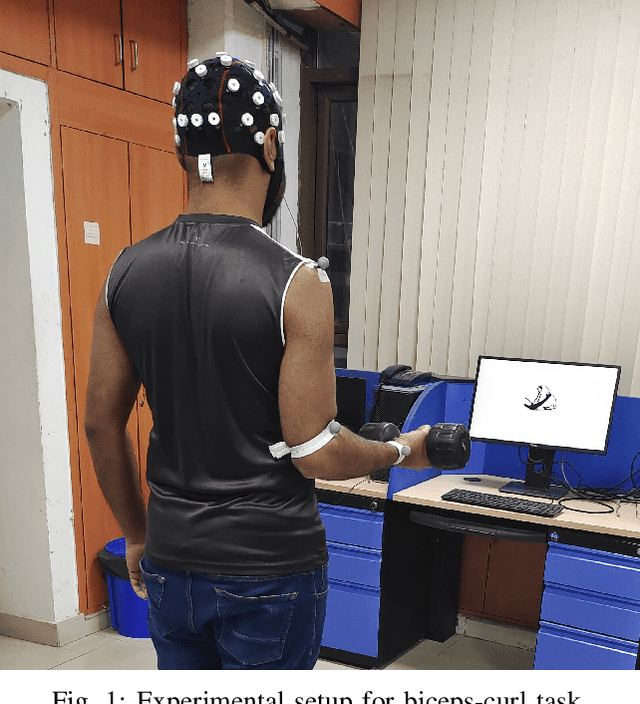

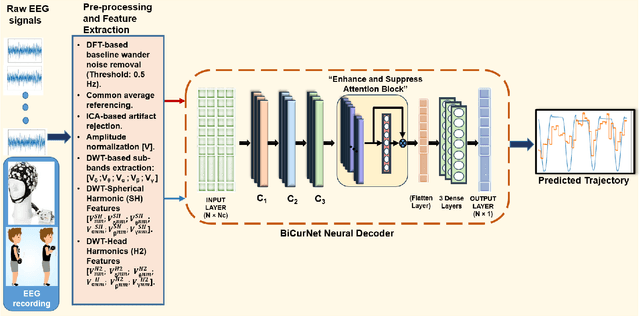

Abstract:Kinematic parameter (KP) estimation from early electroencephalogram (EEG) signals is essential for positive augmentation using wearable robot. However, work related to early estimation of KPs from surface EEG is sparse. In this work, a deep learning-based model, BiCurNet, is presented for early estimation of biceps curl using collected EEG signal. The model utilizes light-weight architecture with depth-wise separable convolution layers and customized attention module. The feasibility of early estimation of KPs is demonstrated using brain source imaging. Computationally efficient EEG features in spherical and head harmonics domain is utilized for the first time for KP prediction. The best Pearson correlation coefficient (PCC) between estimated and actual trajectory of $0.7$ is achieved when combined EEG features (spatial and harmonics domain) in delta band is utilized. Robustness of the proposed network is demonstrated for subject-dependent and subject-independent training, using EEG signals with artifacts.
 Add to Chrome
Add to Chrome Add to Firefox
Add to Firefox Add to Edge
Add to Edge